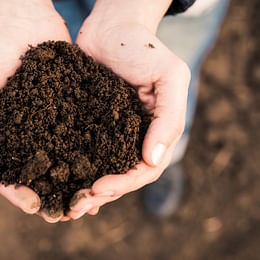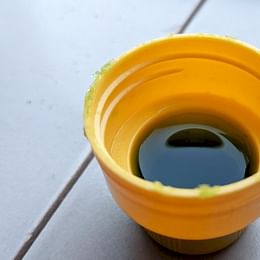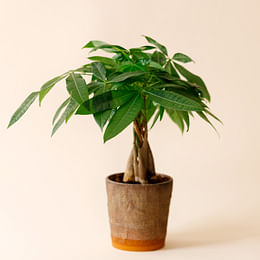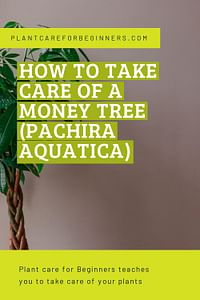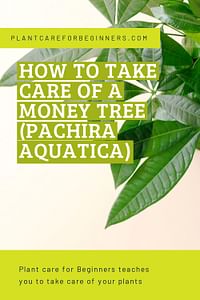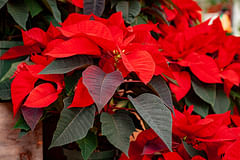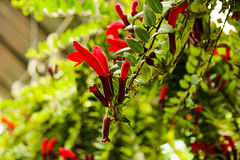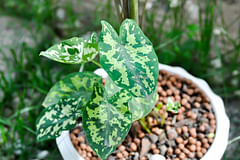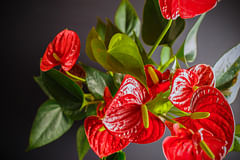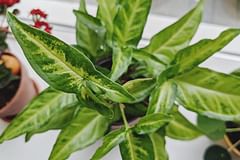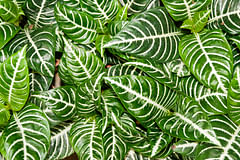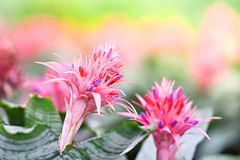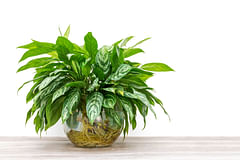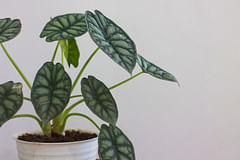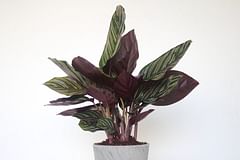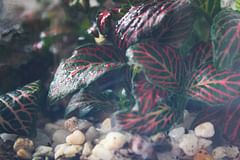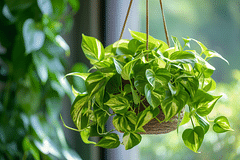How to take care of a Money tree (Pachira Aquatica)
Learn how to care for your Money tree with this beginner-friendly guide. Discover safe practices for pets, tackle common pests and diseases, and explore prevention and treatment options for a thriving plant. Perfect for plant lovers of all levels!
Last updated on:
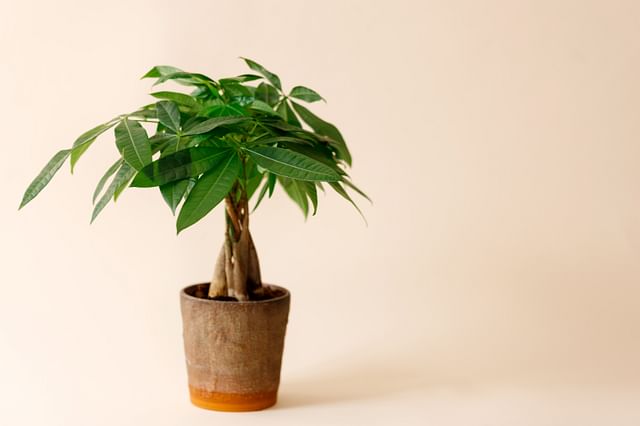
Many houseplants grow quite slowly or stay small. This isn't for everyone, because some of you (including myself) love big and bold plants!
Bigger plants are great statements in any room and will add some texture to your walls or furniture. What if there was a fast-growing statement plant that's also incredibly easy to take care of? Such a plant exists and it's the Money Tree!
If you've considered adding a houseplant to your home, the Money Tree (Pachira Aquatica) is a great option. It's easy to take care of and is known for its ability to bring good luck and fortune.
In this plant care guide, we will discuss how to take care of a Money tree so that it thrives in your environment.
These are the topics we're going to discuss in this plant care guide:
Let's get right into it and help you bring some extra plant care skills to taking care of this lucky tree!
How often should I water my Money tree?
Like most tropical plants, the Money tree also enjoys slightly moist soil. You can keep your Money tree happy by watering the plant when the top inch of soil feels dry to the touch. Depending on the size of your plant and the pot it's in, this may be once a week or once every two weeks.
Before watering, check the top 2-3 inches of soil. If it feels dry, it’s time to water. If it still feels moist, wait a few days and check again.
Water slowly and deeply, until water starts to come out of the drainage holes at the bottom of the pot. Allow the plant to drain for a few minutes until the excess moisture has drained from the pot. Be sure to not overwater your plant as this can cause root rot.
The Money Tree loves moist soil but doesn't like to grow in standing water. It stores a lot of moisture in its stems, so it prefers to soak up the moisture from the moist soil and let the soil dry out before you water it again.
Signs of under- and overwatering
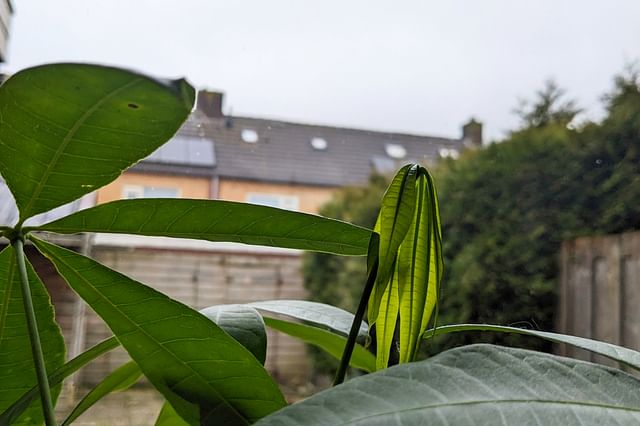
Watering your plant perfectly every time can be difficult. Sometimes you give it a little too much and you might forget to water your plant from time to time. In this section we'll look at the signs of over- and underwatering, so you know what to look out for. Here’s how you can tell the difference:
Signs of Overwatering
Overwatering your plant is one of the biggest mistakes you can make when it comes to taking care of plants. Luckily it's not very easy to do with this thirsty plant, but here are common signs something is wrong:
Yellowing leaves
If the leaves of your Money tree are turning yellow, it might be a sign of too much water. Overwatering can lead to root rot, which stops the plant’s ability to absorb nutrients properly.
Soft, mushy stems or leaves
Excess moisture can cause the stems and leaves of the Money tree to become soft and mushy, as the plant’s cells are over-saturated with water.
Mold or algae on the soil surface
Overwatering creates a damp environment that is convenient for the growth of mold, mildew, or algae on the soil surface.
Foul smell from the soil
An unpleasant odor coming from the potting mix can indicate root rot, which is often caused by excessive watering.
Waterlogged soil
If the soil feels soggy or water sits on the surface for a long time after watering, it’s a sign that the plant is overwatered.
Signs of Underwatering
Not watering your plant enough is quite easy with the Pachira Aquatica. Even in the winter, you'll need to water it at least once every 14 days for it to not start to dry out. Here are some common signs your plant needs moisture:
Dry, Brown leaf edges
The edges of the leaves may turn brown and crispy when the plant isn’t receiving enough water.
Drooping leaves
Money tree leaves may droop or wilt as a response to insufficient water intake.
Slow growth or no growth
Underwatering can significantly slow down the growth of your Money tree or stop it altogether.
Dry, compact soil
If the soil feels hard and dry to the touch, it’s a sign that the plant needs more water.
Leaf drop
In severe cases of underwatering, a Money tree may begin to shed its leaves as a survival method.
How much light does a Money tree need?
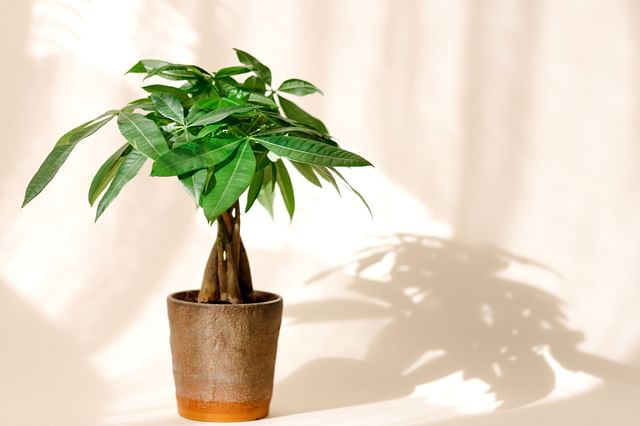
The Money tree naturally grows in freshwater swamps and river banks in tropical rainforests in Central America. Knowing the natural habitat of the plant helps us understand how much light a Money tree needs. Money trees prefer bright, indirect light but can also tolerate low-light conditions.
If you are growing your Money tree indoors, place it near a window where it will receive plenty of natural light. However, make sure your money tree isn't getting too much direct sunlight. Too much direct light can cause the leaves to bleach and too little sunlight makes the plant become leggy. When a plant becomes "leggy" that means it has long, stretched stems, with just a few leaves on the top.
How can you tell if a Money tree is getting too much or too little sunlight?
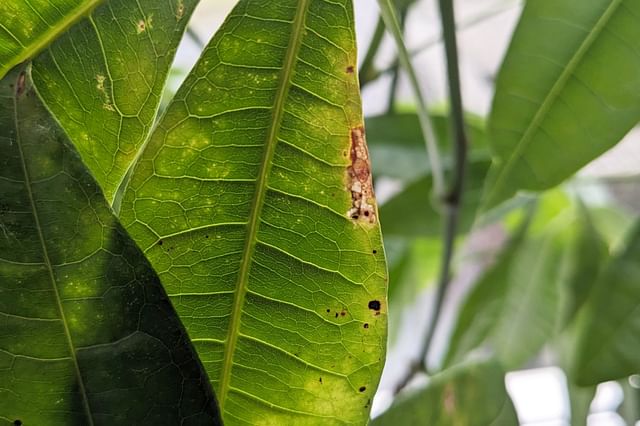
Accidents happen and your plant could get too much or too little sunlight in its current spot. Here are some signs that can help you determine whether your Money tree is getting too much or too little sunlight:
Signs of too much sunlight
You'll know your Pachira Aquatica is getting too much sunlight if you notice any of these signs.
- Scorched or sunburned leaves: If the leaves of your Money tree appear bleached, have brown scorched spots, or look crispy, it might be receiving too much direct sunlight.
- Fading leaf color: Excessive sunlight can cause the leaves' vibrant green color to fade or become pale.
- Wilting: Even with watering your plant correctly, leaves may wilt if the plant is under stress from too much sun.
- Dry soil: The soil drying out too quickly after watering can also be a sign that the plant is in too bright an area, leading to increased evaporation.
If you notice any of these signs, it's a good idea to move your plant further away from a window to give it the bright, but indirect sunlight it likes.
Signs of too little sunlight
- Leggy growth: When a Money tree doesn’t receive enough light, it may stretch toward the light source, resulting in long, spindly stems. This condition is known as etiolation.
- Small leaves or sparse leaf growth: Insufficient sunlight can lead to smaller than usual leaves or sparse growth as the plant struggles to photosynthesize.
- Leaning: If your Money tree is leaning significantly toward one direction, it might be trying to reach for more light, indicating that the current light levels are inadequate.
- Slow growth or no growth: A lack of sunlight can severely slow down the growth of your Money tree or stop it altogether.
If you notice any of these signs, you should move your plant to a brighter spot. If you don't have a brighter spot, you could consider a grow light to give your plant a boost.
The ideal temperature for a Pachira Aquatica
Money trees have a specific temperature range in which they're happy and can thrive. Since these plants are native to the swamps of Central and South America, they are used to warm and humid conditions.
During the day they thrive in temperatures between 18 and 27 degrees Celsius (65 to 80 F). At night, Money trees prefer slightly cooler temperatures but should not get temperatures below 10 degrees Celsius (50 F).
One important thing about temperatures for your Pachira Aquatica is that they should be stable. Don't place your plant close to heating or air conditioning units to avoid stressing out your plant. This stress can cause leaf drop and slow down its growth.
How much humidity does a Money tree need?
We've already learned that the Money Tree naturally grows in swamps in South America. If you look at its natural habitat, you'll see that it likes humidity. Like its natural rainforest habitat, the Money tree requires humidity; about 50-60%.
You can provide this by using a humidifier or placing the plant's pot on a tray filled with pebbles and water. If you're looking for other ideas to raise the humidity in your house or around your plant, have a look at "10 ways to raise the humidity in your house".
How large does a Money tree grow?
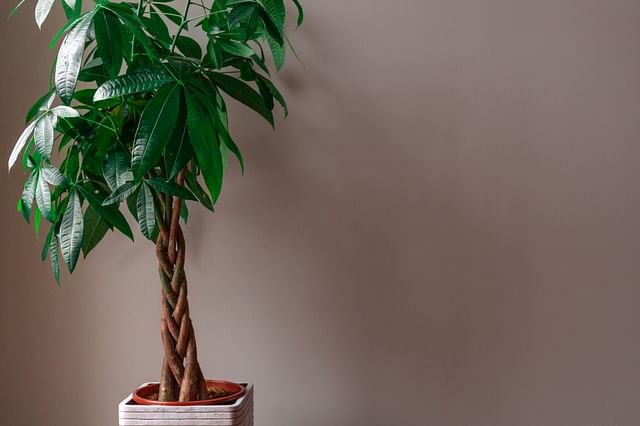
A Money tree can grow up to 60 feet tall in its natural habitat, but it will only reach a fraction of that size when grown indoors. A potted Money tree will typically only grow to be about 180cm to 200cm (six to seven feet) tall when placed indoors.
Not only does it grow quite tall, but it also likes to grow horizontally once it has reached its "indoor" height. Put all of this together, and the plant will be quite a large plant in your house or office once it has fully grown. You can trim the plant back and use the cuttings to propagate this plant, but more on that later!
What type of soil should I use for my Money tree?
Since we know the Money Tree likes to be in moist soil but not sitting in a puddle, this will help us find out what type of soil to use. The Money tree grows best in rich, loamy soil that is well-draining. You can use most general houseplant potting soils, as these usually contain plenty of nutrients and drain quite well.
You can also make your soil mix by combining one part potting soil, one part peat moss, and one part perlite. This mixture lets oxygen through quite well, holds onto moisture, but also drains excess moisture quite quickly. This allows your Money tree to soak up all the moisture it needs, with a low chance of getting root rot.
If your pot does not have drainage holes, make sure to add a layer of rocks or gravel to the bottom before adding the soil. This will help ensure that excess water can drain out of reach of the soil and avoid root rot. Also if you're unable to water your Money tree for a longer period, you can add a layer of mulch to the soil surface to retain moisture.
When should I fertilize my Money tree?
Fertilizing your plants can help them grow and also be more resistant to pests. I recommend fertilizing your Money tree every 2-3 weeks during the growing season (Spring and Summer). You can use a standard houseplant fertilizer or a slow-release fertilizer. Be sure to follow the instructions on the fertilizer package for how much to use.
During the fall and winter, you shouldn't fertilize your Money tree at all, as it won't need the extra energy to grow. During this time, the Money Tree will slow down its growth until the spring as it enters its dormancy period. You shouldn't fertilize your plant in its dormancy, as this could lead to overfertilizing. Overfertilizing can burn the roots of your plant, which will slowly kill the plant.
Are you looking for more information about seasonal care for a Pachira Aquatica, have a look at Seasonal care for a Pachira Aquatica.
How often should I repot my Money tree?
Repotting your plants is essential for encouraging growth and keeping your plants happy. It is recommended to repot your Money tree every two to three years. This timeframe allows the plant to grow without becoming too pot-bound. Repotting provides the Money tree with fresh soil, and more room to grow, and can help prevent root rot and other issues associated with compacted or exhausted soil.
The best time to repot a Money tree is during the spring and early summer. This period aligns with the plant's active growth phase, allowing it to recover quickly and adjust to its new pot and soil environment. When repotting, make sure you choose a pot that's slightly larger (1-2 sizes) than the current one and has good drainage holes to prevent water accumulation and possible root issues.
Remember, signs that your Money tree may need repotting include visible roots at the surface of the soil or coming out of the drainage holes, yellowing leaves, or if the plant dries out more quickly than usual, indicating that the roots have possibly become pot-bound.
Are you wondering how you should repot your Pachira Aquatica? Have a look at How to repot a Pachira Aquatica.
How can I prune and shape my Money tree?
Pruning and shaping your Pachira aquatica is essential for keeping it healthy, encouraging growth, and keeping it looking its best. The best time to prune and shape your Money tree is Spring or early summer. This time of year is the plant's active growth phase and helps it to recover quickly from pruning. Here's a step-by-step guide to pruning your Money tree:
Inspect the plant
Before you start, take a good look at your plant. Find any dead, unhealthy, or browning leaves and stems, as well as any overgrown branches that disrupt the plant's shape.
Remove dead or unhealthy parts
Gently remove any parts of the plant that are dead or show signs of disease. This step is crucial for the overall health of your Money tree and can be done at any time of the year.
Shape your plant
To encourage a bushier appearance, focus on trimming long, leggy stems. Making cuts near a leaf node (the point on a stem where leaves are attached) encourages the plant to branch out.
Control size and shape
If your goal is to maintain or reduce the size of your Money tree, or to achieve a specific shape, trim the branches accordingly. However, always prune sparingly, removing a little at a time to avoid over-pruning.
Prune dominant growth
To promote more even growth, consider snipping off dominant growth. This practice helps distribute growth more evenly throughout the plant rather than allowing one or two shoots to dominate.
Post-pruning care
After pruning, make sure your plant receives adequate water and light to support its recovery and new growth. Avoid fertilizing immediately after pruning to prevent stressing the plant.
When pruning your Pachira Aquatica, make sure not to trim too much at once, as this can harm the growth of your plant. Also, always use clean tools to avoid spreading diseases from one plant to another.
How can I propagate a Money tree?
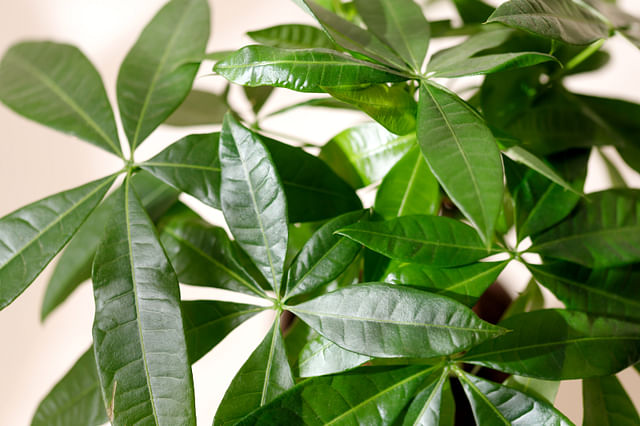
Pachira Aquatica can quite easily be propagated through three different techniques; seed, cuttings, or air-layering. Let's look at the instructions for each method below.
Seeds
To propagate through seed, plant the seeds in a moist potting mix. Cover the seed container with plastic wrap to help retain moisture and place it in a warm location. Keep the soil moist but not soggy and germination should occur within two to three weeks.
Cuttings
To propagate through cuttings, take a six-inch cutting from a healthy Money tree and remove the bottom leaves. Dip the cut end of the stem in rooting hormone and plant it in a moist potting mix. Cover the cutting with plastic wrap to help retain moisture and place it in a warm location. Keep the soil moist but not soggy and new roots should form within four to six weeks.
Air-layering
To propagate through air-layering, choose a branch on your Money tree that is at least six inches long. Make a small cut in the bark of the branch and dust the wound with the rooting hormone. Wrap the wounded area tightly with moist sphagnum moss and secure it with plastic wrap or twist ties. Keep the moss moist and new roots should form within four to six weeks. Once the roots have formed, you can cut the branch below the moss and pot it up in a moist potting mix.
I advise that you wear gloves and avoid touching the skin around your eyes during propagation, as the sap can sometimes irritate.
Is a Money tree safe for pets?
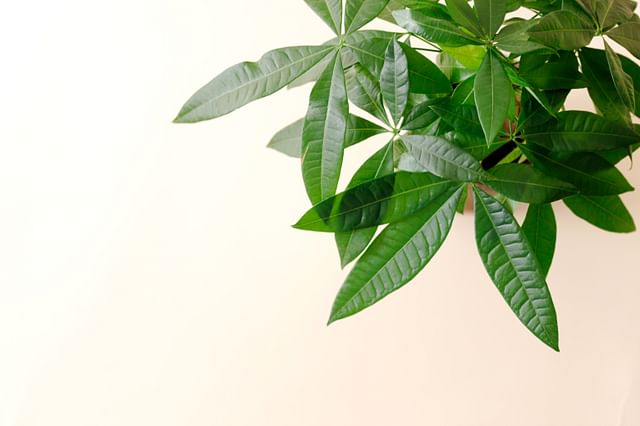
The Money Tree is generally considered to be safe for pets, but it is always best to consult your veterinarian if you have any concerns. The main concern with the Money tree is that its leaves can cause an upset stomach if ingested in large quantities. Also, the plant's sap can be irritating to the skin and eyes, so it is best to keep pets and small children away from the Money tree.
If you think your pet has eaten a large amount of any plant, it is always best to contact your veterinarian.
Common pests, diseases, and treatment for a Pachira Aquatica
Pachira Aquatica can be susceptible to several pests and diseases, but they are generally considered to be hardy indoor plants. Here are some of the most common issues to watch out for:
Common pests
- Spider Mites: These tiny spider-like pests can be hard to see with the naked eye but can cause significant damage. They suck sap from the leaves, leading to yellowing, browning, and eventually leaf drop. Fine webbing on the plant is a telltale sign of spider mite infestation.
- Mealybugs: Recognizable by their white cottony appearance, mealybugs feed on plant sap, weakening the Money tree. They tend to gather in leaf axils or along stems.
- Aphids: Small, pear-shaped insects that can be green, yellow, brown, red, or black. They suck sap from the leaves and stems, causing distorted growth and a sticky residue known as honeydew, which can lead to sooty mold.
- Scale Insects: These pests attach themselves to the stems and leaves, feeding on the plant's sap. They appear as small, brown, dome-shaped bumps on the plant and can be hard to remove manually.
After the diseases below, we'll look at what you can do to help your plant when it's suffering from pests.
Common diseases
- Root Rot: Overwatering is the primary cause of root rot, which occurs when the roots sit in excess moisture for too long, leading to fungal infections. Signs include yellowing leaves, stunted growth, and a mushy base or roots.
- Leaf Spot Diseases: Fungal or bacterial infections can cause dark or discolored spots on the leaves. Ensuring good air circulation and avoiding wetting the foliage can help prevent these diseases.
- Powdery Mildew: This fungal disease appears as white powdery spots on the leaves and stems. It usually occurs when there is high humidity combined with poor air circulation around the plant.
Now that we've looked at the most common pests and diseases, it's helpful to also find out how we can help our Pachira Aquatica recover from these problems. Let's find out.
Prevention and treatment
There are a few things you can do to prevent pests and diseases from showing up on your plant in the first place. To prevent these problems, follow these 3 steps: Isolate, water properly, and regularly inspect your plants.
When introducing new plants to your home, keep them isolated from your other plants for a few weeks to monitor for pests or diseases. Avoid overwatering and make sure your Money tree is planted in well-draining soil to prevent root rot, and regularly check your plant for signs of pests or disease. Early detection is key to effective treatment.
But issues can slip through the cracks, and pests and diseases happen, so what can you do to treat your plants? Let's look at these 2 options: Neem oil, and insecticidal soap.
Neem oil is an organic option for treating many pests and some fungal diseases. Mix a few drops of it with a few drops of liquid dish soap and warm water in a spray bottle. Shake well and spray your plants with this mixture to kill pests on your plant.
You can also use insecticidal soap to fight off pests. It's especially effective against many soft-bodied pests like aphids and mealybugs. Make sure to cover all parts of the plant, including the undersides of leaves.
Conclusion
That's all you need to know about how to take care of a Money tree! Taking care of your Money tree can be simple- with plenty of indirect sunlight, a well-draining rich, and loamy soil, enough water for slightly moist topsoil, and fertilizer during the growing season (Spring and Summer). With proper care, your Money tree will thrive indoors and bring you good luck for years to come.
I hope you found this guide helpful! Please share it with your friends and family to help them take care of their plants too. If you have any questions, please don't hesitate to reach out to me or ask the members of the Plant Care for Beginners Facebook Group for help!
Thank you for reading this post! I hope it helps you to keep your plants healthy and beautiful! If you're looking for more guides on specific plants, you can always request a plant guide to get a guide for the plant you have trouble with.
Tags: Plant care tips, moisture-loving, tropical
Posted on: Oct 1, 2022 Last updated on: Feb 29, 2024